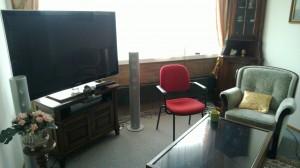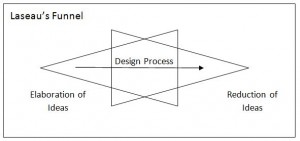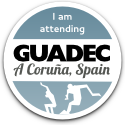Sketching interactions (talk at GUADEC 2012)
Posted in Design, Free Software, Gnome, GUADEC, Igalia, Planet GNOME, Planet Igalia, Web browsing on July 31st, 2012 by femorandeira – 2 CommentsThis is a small summary of my talk at GUADEC 2012 in A Coruña, Spain.
I got the talk started with a quote from Bill Buxton‘s book “Sketching User Experiences”:
“Getting the design right, and the right design”
“Getting the design right” refers to the things that concern us when refining a design: usability, accessibility, visual appearance, performance, etc.
However, what exactly is “the right design”?
Here are photos of three objects to help us start thinking about this.
The first one is an old car in Cuba, carefully kept and maintained. Terribly attractive at a first look. After this first impression, questions begin to come up. Is it easy to handle? Expensive to maintain? Ecological?
The second photo shows a set of Japanese knives. Are they beautiful? Kind of, as far as knives go. They feel great in the hand, though, and are sharp and sturdy. And what do they tell about their owner? What would it say about yourself to own a set like this?
The third photo is a small figurine of the Eiffel Tower. It is not particularly attractive. It is absolutely, perfectly useless. And yet, it has value for its owner. But that value does not come from its looks of its usage. The value of this object is not in the object itself: it comes from how it makes its owner think (in this case, of a past trip to Paris).
There have been different attempts at defining the characteristics that make things attractive and valuable for us. In his book “Emotional Design”, Donald Norman details three levels of processing:
- Visceral: related to the sensory properties of a product
- Behavioural: how it feels when used
- Reflective: how it makes us think differently about ourselves, and how it changes the perception of others
A more recent approach has been carried out by Karen Holtzblatt (InContext). She and her team identified a set of characteristics that make a product “cool”:
- Allows you to accomplish your intent anywhere, on your time
- Goes direct into action without hassle
- Provides connection with the people that matter to you
- Helps you build your own identity
- Has nice aesthetics and sensation
Laseau’s funnel describes design as a combination of ideation and reduction. There are many different solutions to explore at the beginning of a project, and we need to be able to go through all those ideas quickly, evaluating and rejecting them. Making questions upon questions in order to start getting the right answers.
Requirements-driven development is not enough to provide the characteristics that people really value. A much better approach is to be able to quickly try out design ideas, using those sketches to help us elicit the real user requirements and refine the designs.
These sketches need to be fast and cheap, so that they can be plentiful. And because they are plentiful and cheap and fast, they can be disposed of, to leave room for more and better ideas.
As it is often said, design is about saying “no”: design is a negative craft.
Besides its benefits for ideation, this approach also helps improving the communication of design ideas among designers, and between them and other stakeholders (i.e. the GNOME community at large, in our case).
One (surprisingly) influential film for the field of UX design has been “The Wizard of Oz”. You are probably familiar with the story: Dorothy’s house is carried away by a tornado, all of a sudden she is not in Kansas any more, she meets a cast of wacky characters and runs into several adventures until she and her friends finally meet the famous Wizard of Oz.
Large, loud and surrounded by fire, the Wizard is a terrible and dreadful sight. Dorothy and her friends are appropriately afraid and have no choice but to do as he commands. Until the little dog Toto gets so scared that he runs and pulls at a curtain: behind it there is a small old man, pulling levers.
So the terrible Wizard was actually just an old man using smoke and mirrors. But what’s interesting is that, up until the point of this revelation, Dorothy’s and her friend’s reactions were governed by the belief that he was real. The Wizard was fake, but their experiences of him weren’t.
The Wizard of Oz is actually the name of a specific technique for sketching interactions where part of the behaviour of a computer system that would be too expensive to build is replaced by a hidden human operator. It has been successfully used to, for instance, simulate the experience of using a perfectly accurate speech-to-text system way before those systems were as common as they are beginning to get today.
The talk continued with descriptions of a number of examples and different techniques to quickly sketch the behaviour and experience of using a product way before that product is a reality. Several tangible prototypes were discussed, from simple paper-based sketches to full living rooms.

Living room at CWI Amsterdam, used to conduct experiments on different TV and teleconferencing technologies.
Some of the examples relied on storytelling engage the audience’s empathy to help them experience the proposed interaction through the protagonists of the story. The cases discussed ranged from written stories to the acting up of interaction flows and even professional theatre performances.
In GNOME, we often use wireframes and visual mockups. A couple of interactive examples that were discussed in the talk were:
- This demo of multiple selection by Jakub Steiner (link)
- And my own experiments with the navigation on Epiphany (code, videos)
Communication of design decisions is a problem in GNOME. We are a project composed of small teams working on different and remote organisations, but with a lot of potential stakeholders (a whole community of them!). It is important to develop and practice techniques that would allow us to refine and communicate ideas more fluently.
To end with a bit of advice: just turn your computer off from time to time, grab some pen & paper, and try things out 🙂
Images:
- https://secure.flickr.com/photos/patrick_nouhailler/5507717586/
- https://secure.flickr.com/photos/osakajon/127131454/
- https://secure.flickr.com/photos/esm723/3074137958/
- http://www.imdb.com/title/tt0032138/
- http://www.computerhistory.org/collections/accession/102716262
- http://www.cwi.nl/
- http://www.computing.dundee.ac.uk/staff/afn/







